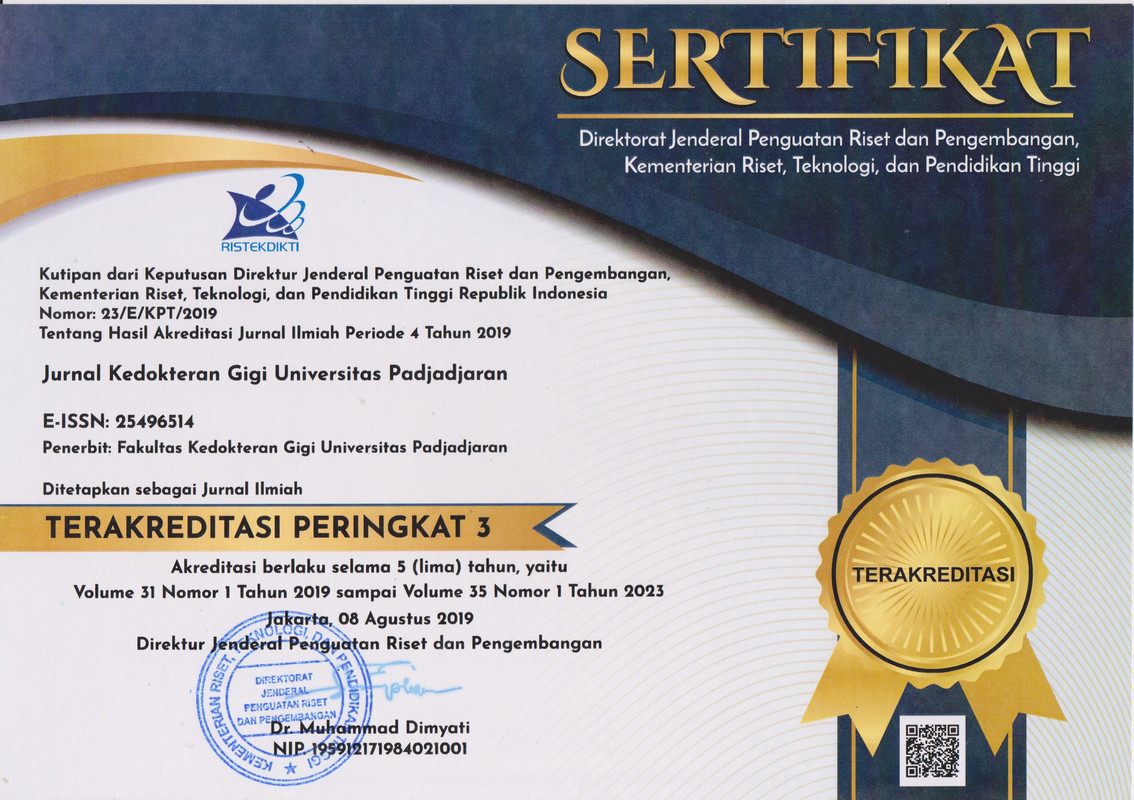Single visit root canal treatment of a third lower molar with curved canal and Class II disto-occlusal caries: Case report
Abstract
ABSTRACT
Introduction: Root canal treatment (RCT) of mandibular third molars is often considered challenging due to anatomical variability, limited accessibility, and difficulty achieving proper isolation. As a result, extraction is frequently chosen. This case report outlines a successful single-visit RCT on a right mandibular third molar with a curved canal and Class II disto-occlusal caries. Case Report: A 30-year-old female presented with a large cavity on her right lower molar and requested a restorative treatment. Three weeks earlier, devitalization and temporary restoration had been performed by another dentist. Clinical examination revealed no periapical lesion, and percussion testing was negative. Radiographic analysis showed a slight curvature in the distal canal. A pre-curved K-File and the One Curve System were used for instrumentation. The canal was obturated in a single visit, followed by restoration using direct composite and short fiber-reinforced composite. Matrix and PTFE tape were utilized for proper adaptation in the distal area. Conclusion: With accurate diagnosis, understanding of anatomical complexity, and appropriate technique, single-visit RCT on mandibular third molars is achievable. This case supports the viability of conservative treatment for necrotic third molars with asymptomatic apical periodontitis, avoiding unnecessary extraction.
Keywords
single visit, root canal treatment, third lower molar, curved canal, composite restoration.
ABSTRAK
Pendahuluan: Perawatan saluran akar (RCT) pada molar ketiga mandibula menantang karena variasi konfigurasi saluran, kesulitan akses ke area posterior, dan tantangan dalam isolasi. Akibatnya, pencabutan sering menjadi pilihan. Laporan kasus ini mendeskripsikan protokol RCT kunjungan tunggal pada molar ketiga kanan mandibula dengan saluran melengkung dan karies disto-oklusal kelas II. Laporan Kasus: Seorang wanita 30 tahun datang dengan kavitas besar pada molar ketiga kanan bawah dan menginginkan perawatan tanpa pencabutan. Tiga minggu sebelumnya, dokter lain telah melakukan devitalisasi dan restorasi sementara. Pemeriksaan klinis menunjukkan tidak ada lesi periapikal dan uji perkusi negatif. Radiograf menunjukkan kelengkungan ringan pada saluran distal. RCT dilakukan menggunakan K-file pra-lengkung dengan sistem One Curve. Obturasi dilakukan dalam satu kunjungan, diikuti restorasi komposit langsung yang diperkuat dengan komposit serat pendek. Area distal direstorasi menggunakan matriks dan pita PTFE. Simpulan: RCT kunjungan tunggal pada molar ketiga mandibula dengan pulpa nekrotik dan periodontitis apikal asimptomatik dapat berhasil dilakukan dengan diagnosis akurat dan teknik yang tepat. Pendekatan konservatif ini menunjukkan bahwa pencabutan bukan satu-satunya pilihan.
Kata kunci
sekali kunjungan, perawatan saluran akar, molar ketiga, saluran melengkung, restorasi komposit.
Keywords
Full Text:
PDFReferences
REFERENCES
Nissa G, Amit G. Textbook of endodontics. 1st ed. Jaypee Brothers Medical Publishers; 2019. p. 1-540.
Ritter A, Boushell LW, Walter R. Sturdevant’s Art and Science of Operative Dentistry. 7th ed. Elsevier Health Sciences. 2018. p. 1-544.
Bobby P. Endodontic Treatment, Retreatment, and Surgery: Mastering Clinical Practice. Thammasat University Library. 2016. p.473
Schwendicke F, Göstemeyer G. Single-visit or multiple-visit root canal treatment: systematic review, meta-analysis and trial sequential analysis. BMJ Open. 2017;7(2):e013115. https://doi.org/10.1136/bmjopen-2016-013115
Wong AW, Tsang CS, Zhang S, Li KY, Zhang C, Chu CH. Treatment outcomes of single-visit versus multiple-visit non-surgical endodontic therapy: a randomised clinical trial. BMC Oral Health. 2015;15:162. https://doi.org/ 10.1186/s12903-015-0148-x.
Londhe SM, Sharma S, Lal S. Single-visit versus dual-visit endodontics – a comparative study. Indian J Public Health Res Dev. 2019;10(7):244–50. https://doi.org/10.5005/jp-journals-10005-1004.
Moreira MS, Anuar ASNS, Tedesco TK, dos Santos M, Morimoto S. Endodontic treatment in single and multiple visits: an overview of systematic reviews. J Endod. 2017;43(6):864–70. https://doi.org/10.1016/j.joen.2017.01.021.
El-Kishawi M, Khalaf K. An update on root canal preparation techniques and how to avoid procedural errors in endodontics. Open Dent J. 2021;15(1):318–24. https://doi.org/10.2174/1874210602115010318.
Karkehabadi H, Siahvashi Z, Shokri A, Haji Hasani N. Cone-beam computed tomographic analysis of apical transportation and centering ratio of ProTaper and XP-endo Shaper NiTi rotary systems in curved canals: an in vitro study. BMC Oral Health. 2021;21(1):595. https://doi.org/10.1186/s12903-021-01617-w.
Shao T, Guan R, Zhang C, Hou B. Influence of operator’s experience on complications of root canal treatment using contemporary techniques: a retrospective study. BMC Oral Health. 2024;24(1):899. https://doi.org/10.1186/s12903-024-03876-9.
Abu-Awwad M. A modern guide in the management of endodontically treated posterior teeth. Eur J Gen Dent. 2019;8(2):63–70. https://doi.org/10.4103/ejgd.ejgd_76_19.
Kimble P, Stuhr S, McDonald N, Venugopalan A, Campos MS, Cavalcanti B. Decision making in the restoration of endodontically treated teeth: Effect of biomimetic dentistry training. Dent J (Basel). 2023;11(7):193. https://doi.org/10.3390/dj11070159.
Belli S, Eraslan O, Eskitascioglu G. Direct restoration of endodontically treated teeth: a brief summary of materials and techniques. Curr Oral Health Rep. 2016;2(4):182–9. https://doi.org/10.1007/s40496-015-0068-5.
Soto-Cadena SL, Zavala-Alonso NV, Cerda-Cristerna BI, Ortiz-Magdaleno M. Effect of short fiber-reinforced composite combined with polyethylene fibers on fracture resistance of endodontically treated premolars. J Prosthet Dent. 2023;129(4):365.e1–10. https://doi.org/10.1016/j.prosdent.2023.01.034.
Rajak DK, Pagar DD, Menezes PL, Linul E. Fiber-reinforced polymer composites: manufacturing, properties, and applications. Polymers (Basel). 2019;11(10):1667. https://doi.org/10.3390/polym11101667.
Putri AR. Crown down preparation technique with large taper endodontic hand instrument. Interdental J Ked Gi. 2021;17(1):41–8. https://doi.org/10.46862/interdental.v17i1.2075.
American Association of Endodontists. Treatment Standards [White Paper]. Chicago (IL): American Association of Endodontists; 2018.
Kosturkov D, Radeva E, Uzunov T. Digital determination of curvature of root canals of extracted teeth. Acta Med Bulg. 2020;47(1):32–5. https://doi.org/10.2478/amb-2020-0005.
Balani P, Niazi F, Rashid H. A brief review of the methods used to determine the curvature of root canals. J Restor Dent. 2015;3(3):57–63.
Hawi N, Pedullà E, La Rosa GRM, Conte G, Nehme W, Neelakantan P. Influence of coronal flaring on the shaping ability of two heat-treated nickel-titanium endodontic files: a micro-computed tomographic study. Clin Med. 2023 ;12(1):357. https://doi.org/10.3390/jcm12010357
Micoogullari KuS, Kaval ME, Serefoglu B, Kandemir Demirci G, Çalışkan MK. Cyclic fatigue resistance and energy dispersive X-ray spectroscopy analysis of novel heat-treated nickel–titanium instruments at body temperature. Microsc Res Tech. 2020 J;83(7):790–4. https://doi.org/10.1002/jemt.23469.
Topçuoğlu HS, Topçuoğlu G, Kafdağ Ö, Balkaya H. Effect of two different temperatures on resistance to cyclic fatigue of One Curve, EdgeFile, HyFlex CM and ProTaper Next files. Aust Endod J. 2020 Apr 1;46(1):68–72. https://doi.org/10.1111/aej.12369.
Kottoor J, Kottoor T. Comparison of stainless steel file with NiTi coated stainless steel file using electron beam physical vapour deposition process. Dayananda Sagar Int J Sci Eng Manag. 2013;1:1–7. Available from: https://www.researchgate.net/publication/258995790.
Plotino G, Nagendrababu V, Bukiet F, Grande NM, Veettil SK, De-Deus G, et al. Influence of negotiation, glide path, and preflaring procedures on root canal shaping—terminology, basic concepts, and a systematic review. J Endod. 2020;46(6):707–29. https://doi.org/10.1016/j.joen.2020.01.023.
Bernardes RA, Duarte MAH, Vasconcelos BC, Bramante CM, Silva EJNL. Clinical reproducibility of Tri Auto ZX2 dedicated motor and electronic foraminal locator in determining root canal working length. G Ital Endod. 2021;35(1):196–200.
Tekçe N, Aydinbelge M, Sahin D, Mese TA, Topaloglu S, Serper A, et al. Clinical performance of direct posterior composite restorations with and without short glass-fiber-reinforced composite in endodontically treated teeth: 3-year results. J Adhes Dent. 2020;22(2):127–37.
Peumans M, Venuti P, Politano G, Van Meerbeek B. Effective protocol for daily high-quality direct posterior composite restorations: the interdental anatomy of the class-2 composite restoration. J Adhes Dent. 2021;23(1):21–34. https://doi.org/10.3290/j.jad.b916819.
Sattar MM, Patel M, Alani A. Clinical applications of polytetrafluoroethylene (PTFE) tape in restorative dentistry. Br Dent J. 2017;222(3):151–8. https://doi.org/10.1038/sj.bdj.2017.110.
Fráter M, Sáry T, Vincze-Bandi E, Volom A, Braunitzer G, Szabó PB, et al. Fracture behavior of short fiber-reinforced direct restorations in large MOD cavities. Polymers (Basel). 2021;13(13):2040. https://doi.org/10.3390/polym13132040.
DOI: https://doi.org/10.24198/jkg.v37i1.58361
Refbacks
- There are currently no refbacks.
Copyright (c) 2025 Jurnal Kedokteran Gigi Universitas Padjadjaran
INDEXING & PARTNERSHIP

Jurnal Kedokteran Gigi Universitas Padjadjaran dilisensikan di bawah Creative Commons Attribution 4.0 International License






.png)

















